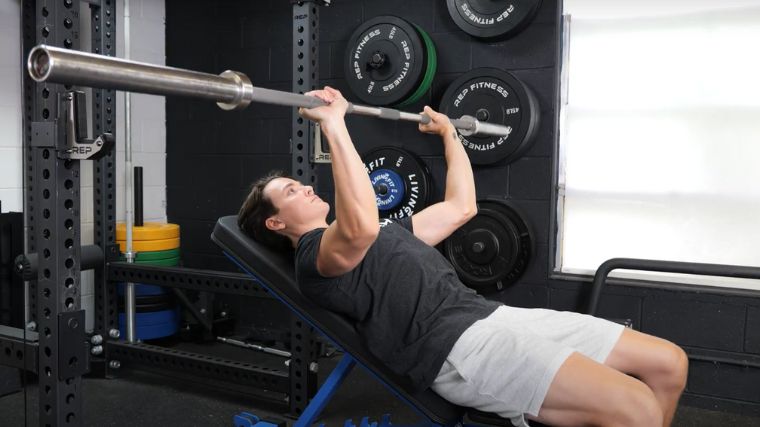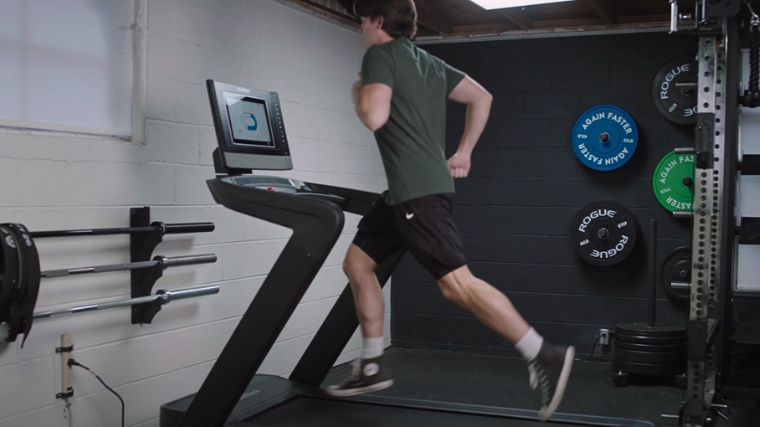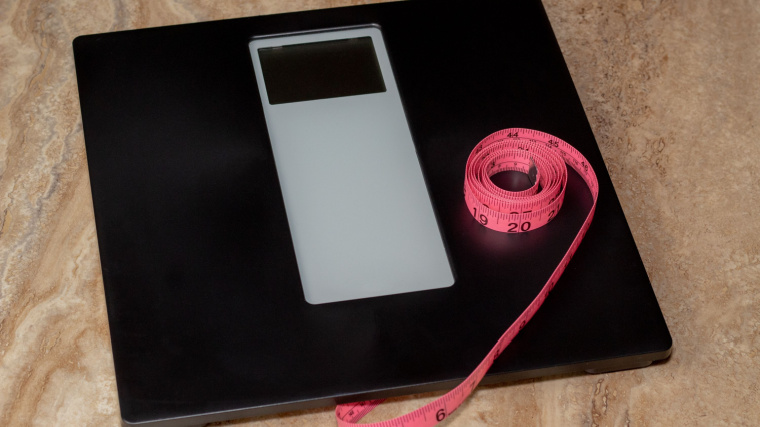When you think about calories being “burned,” you’re thinking about how much energy your body uses at any given time. Most often, we’re taught to think about daily calorie intake and expenditure in terms of our activity levels. For example, what amount of calories are you burning on the treadmill or during your strength training session?

But your body uses calories — energy — for basic functions, too. You regulate your body temperature, digest food, and breathe, all in a day’s work. That’s the basal metabolic rate, or BMR. Your BMR refers to how much energy (calories) you need simply for a baseline of human survival. How does that impact your fitness? Let’s dive in and find out.
Editor’s Note: The content on BarBend is meant to be informative in nature, but it should not be taken as medical advice. When starting a new training regimen and/or diet, it is always a good idea to consult with a trusted medical professional. We are not a medical resource. The opinions and articles on this site are not intended for use as diagnosis, prevention, and/or treatment of health problems. They are not substitutes for consulting a qualified medical professional.
What Is BMR?
Basal metabolic rate, or BMR, refers to your body’s resting energy expenditure. In short, it’s a measurement of the amount of energy you need to perform your body’s most basic survival functions. Think: digestion, respiration, regulating your body temperature — the things your body does to survive that you don’t consciously control.
Your BMR is far and away the largest contributor to your total daily energy expenditure (TDEE). Your TDEE includes your BMR, but also takes into account other energy needs. TDEE refers to how many calories you use on every single activity throughout the day — including your BMR and any activities you do, like walking around, exercising, or even fidgeting.
But what is a calorie? It might be disorienting to think about calories outside the typical, “I burned this many calories on the elliptical” or “This food contains that many calories.” A calorie is simply a unit of energy (much like an inch or centimeter is a unit of distance).

[Read More: Is a Calorie Just a Calorie? An RD Weighs In]
One kilocalorie — which is technically what we’re talking about when we talk about one calorie — is the amount of energy needed to increase the temperature of one gram of water by one degree Celsius. We measure the amount of energy you’re using on any given day with calories. You need to consume calories to give yourself the energy you need to fuel your body’s functions.
To sum it up: The amount of calories you need to perform your body’s most basic functions, at complete rest, is your basal metabolic rate, or BMR.
What Determines BMR?
While a lot contributes to BMR, including genetics, there are four major factors that contribute to calculating a person’s BMR. Each of these four “ingredients” has been found to profoundly affect how many calories you need to perform your essential body functions.
Body Composition
Your body is made up of different types of tissue. In addition to your skeleton and other organs, you’ve got lean body mass, or muscle, and free fat mass, or adipose tissue. Lean body mass and fat mass can change significantly depending on strength training and healthy habits.
Lean body mass and total fat mass seem to be reliable predictors of BMR. (1) That’s because muscle is more “energetically expensive” to maintain than fat. All things being equal, the more muscle mass you have, the higher your BMR will be.

[Read More: How Many Calories Should I Eat Per Day? A Guide for All Your Fitness Goals]
This means that knowing your body fat percentage — your overall muscle mass relative to your total fat mass — can provide you with useful information about your BMR.
Body Mass
Even if you and a friend have the same lean muscle mass, the person who has a greater body weight will generally have a higher BMR simply due to a larger body size. (2) The more general body mass there is, the more energy you’ll generally need to sustain it.
Age
As you age, your basal metabolic rate tends to dip. (3) This may have to do with decreases that people often experience in muscle mass as they age. (4) However, the relationship between chronological age and metabolic age is complex, and BMR may decrease as individuals get older even if their body composition stays pretty constant.
Sex Assigned at Birth
The sex that an individual is assigned at birth also seems to play a role in BMR. For example, one BMR study identified a significant association between lean body mass, and the intake of both protein and dietary fat in cis women, but not in cis men. This association between BMR and gender persisted even after taking into account individual fat mass. (5)
[Read More: Fat Loss and Muscle Gain: The Right Macros for Your Goals]
Currently, there are no BMR studies focused on nonbinary people or how hormone replacement therapy may impact the BMR of trans people.
BMR vs. RMR
On the one hand, there’s basal metabolic rate (BMR), and on the other, there’s resting metabolic rate (RMR). These are often used interchangeably, which makes some sense — they’re both indicative of your body’s energy needs when you’re at rest.
However, there’s a key difference between BMR and RMR, outlined here:
- BMR tallies the minimum number of calories you would burn if you performed no conscious activities at all (this becomes especially important for people recovering from extreme illnesses and injuries).
- RMR takes basic daily movements into account. This includes eating, short walking periods, using the restroom, and non-strenuous physical activities. (6)
The things you do each day don’t immediately impact your BMR, whereas your RMR is impacted by your daily activities. For example, a day of rest for you might involve sleeping for a large majority of the day. That will require fewer calories. In that case, your RMR will more closely resemble your BMR because you’re most sticking to life-sustaining functions.
[Read More: How to Achieve a Calorie Deficit for Weight Loss, Safely]
But your calorie needs may be a bit different — your RMR will be higher — if your day of rest involves walking your dog, light stretching, and playing video games. While they’re not necessarily rigorous, those activities will burn calories at a higher rate than sleeping all day.
How to Calculate BMR
Over time, there have been countless equations developed to calculate BMR. Nearly all of them follow the general formula of taking your current weight and multiplying it by a predetermined figure. That number is then added to the product of a separate multiplication formula involving your height.
From there, additional deductions are applied based on age and gender as identified by the researchers. The first widely accepted equation for calculating BMR is the Harris-Benedict equation, which was first published in 1918. (7) It established the standard of calculating BMR by using the products of height, weight, and age calculations, and then adding or subtracting based on sex assigned at birth.
The Mifflin St. Jeor and Katch-McArdle (sometimes called the Cunningham formula) have also come into popular use. The former is useful for people who don’t know their body fat percentage, while the latter requires knowing that particular number.
Don’t want to do any calculations whatsoever? You don’t have to. BarBend’s got a BMR calculator that you can use without having to break out your high school math textbook.
BMR Calculator
[Read More: Best Macros Calculator for Tracking Muscle Gain and Fat Loss]
Why Is BMR Important?
Once you’ve got a sense of the number of calories you burn daily thanks to your basal metabolism, you can do some fine-tuning of your diet and exercise plans. You can identify the caloric marks you should hit if you want to gain additional muscle mass or aim for body recomposition within your present caloric intake. You can also use it as a base number around which to develop a weight-loss plan.
BMR Myths
Because knowing your BMR grants you valuable insight into your body’s inner workings, it can be tempting to apply it in a whole host of ways. Unfortunately, this has prompted misinterpretations about what BMR is and what knowing it can accomplish.
[Read More: How to Calculate Your Macronutrients for Weight Loss]
Misunderstanding BMR’s capabilities can leave you disappointed if you structure the wrong sort of health strategy around it.
Eating Specific Foods Will Change Your BMR
Certain foods are advertised as speeding up (or slowing down) your metabolism. And while some foods may take slightly more energy to digest than others, the overall impact that this might have on your BMR is negligible at best.
Your BMR Is Unchanging
Your BMR is more of a stable figure day-to-day than, say, how many calories you may burn in a given workout. But that doesn’t mean it’s forever unchanging. Your BMR will adapt to several lifestyle factors, including changes in your muscle mass, body size, and age.
Your BMR Is Unstable
While your BMR won’t hold itself perfectly steady, any short-term fluctuations you experience will generally be extremely small. This means the overall influence of your meals, supplements, and workout style over your BMR will be minimal compared to the major factors.
How to Change Your BMR
Because your basal metabolism is heavily influenced by body composition, activities that rearrange the dimensions of your body can sway your BMR over time.
Change Your Weight
Your BMR is heavily dictated by your height, weight, and age. Because you don’t control your height and age, gaining or losing weight is the most likely way for you to significantly change your BMR.

[Read More: How to Manipulate Energy Balance to Lose or Gain Weight]
Therefore, increasing your weight will tend to increase your BMR, while reducing your weight may lower it.
Alter Your Exercise Intensity Level
Studies show that exercisers whose workouts reached higher levels of intensity recorded loftier BMRs in the aftermath of their training. (8)(9) While the influence was relatively small, it does suggest that BMR can be temporarily boosted by the effort level you display during your training.
Modify Your Muscle Mass
Research suggests that people with a higher percentage of muscle mass relative to their overall body weight were shown to have higher BMRs in comparison to people with less muscle mass. (1) Therefore, strength training can be used to alter your body composition over time so that you can burn more calories at rest, even at the same body weight.
Your Takeaways
Your basal metabolic rate isn’t something you can change on a dime — but it’s still helpful to understand. Here’s what you’ve got to know.
- BMR stands for basal metabolic rate. It refers to how much energy (as in, calories) you need to maintain your body’s most basic survival functions — digestion, respiration, and regulating your body temperature.
- Your BMR is largely impacted by your total body mass, body composition (your ratio of metabolically active tissue like muscle to inactive tissue like fat), your age, and the sex you were assigned at birth.
- BMR is different than RMR because BMR is only the most basic bodily functions, while RMR (resting metabolic rate) also includes low-level activities like very short walking around, using the restroom, and fidgeting.
- Eating certain foods won’t change your BMR to any significant degree, but you can alter your BMR over time by changing your body composition.
FAQs
If you’re still wondering what your BMR is and how you can use it to your advantage, we have answers to some key questions below.
What does a BMR tell you?
Basal metabolic rate — or BMR — informs you of how many calories your body burns while it is in a state of complete rest. BMR takes into account the caloric burn associated with unconscious activities, like breathing, digesting food, and pumping blood throughout your body.
What factors can affect my Basal Metabolic Rate (BMR)?
The most crucial factors believed to affect your BMR are your weight, age, assigned sex at birth, and body composition. Some other factors play comparatively minor roles in influencing your BMR, like the intensity level of your exercise.
How do I calculate my BMR accurately?
There are many different ways to calculate your BMR, most of which involve a relatively complex equation. The simplest way to figure out your BMR is to use BarBend’s BMR calculator.
References
- McNab BK. What determines the basal rate of metabolism? J Exp Biol. 2019 Aug 6;222(Pt 15):jeb205591.
- Sabounchi NS, Rahmandad H, Ammerman A. Best-fitting prediction equations for basal metabolic rate: informing obesity interventions in diverse populations. Int J Obes (Lond). 2013 Oct;37(10):1364-70.
- Speakman JR, Westerterp KR. Associations between energy demands, physical activity, and body composition in adult humans between 18 and 96 y of age. Am J Clin Nutr. 2010 Oct;92(4):826-34.
- Vybornaya KV, Sokolov AI, Kobelkova IV, Lavrinenko SV, Klochkova SV, Nikityuk DB. [Basal metabolic rate as an integral indicator of metabolism intensity]. Vopr Pitan. 2017;86(5):5-10. Russian.
- Bi X, Forde CG, Goh AT, Henry CJ. Basal Metabolic Rate and Body Composition Predict Habitual Food and Macronutrient Intakes: Gender Differences. Nutrients. 2019 Nov 4;11(11):2653.
- McMurray RG, Soares J, Caspersen CJ, McCurdy T. Examining variations of resting metabolic rate of adults: a public health perspective. Med Sci Sports Exerc. 2014 Jul;46(7):1352-8.
- Harris JA, Benedict FG. A Biometric Study of Human Basal Metabolism. Proc Natl Acad Sci U S A. 1918 Dec;4(12):370-3.
- Fasanmade AA. Effects of acute changes in exercise intensity on basal metabolic rate in fit young men. Afr J Med Med Sci. 1996 Sep;25(3):231-4.
- Thyfault JP, Bergouignan A. Exercise and metabolic health: beyond skeletal muscle. Diabetologia. 2020 Aug;63(8):1464-1474.